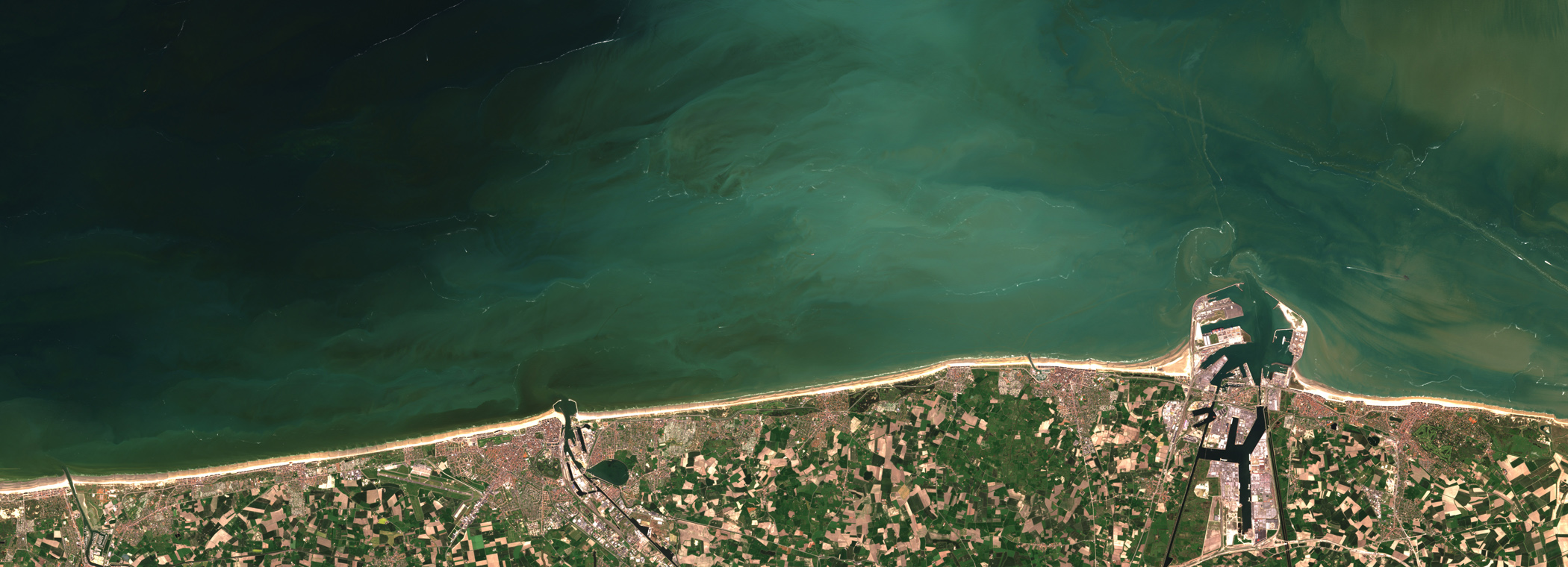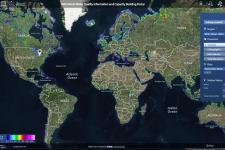What is the importance of water quality monitoring?
How is water quality monitored from space?
Water has specific reflectance characteristics (measured at different wavelengths of light, so-called spectra), based on the scattering and absorbing properties of their optically active constituents. These are directly or indirectly related to relevant water quality parameters (indicator) such as turbidity and suspended matter, phytoplankton and its main pigment chlorophyll, detritus, salinity, total phosphorus (TP), Temperature, pH and dissolved colored organic matter. With the knowledge of their optical characteristics, it is possible to retrieve quantitative values of the concentrations for these water constituents, solely based on the reflectance of light measured by satellite sensors. Different sensors mounted on satellites and other platforms, such as airplanes, measure the amount of radiation at various wavelengths reflected from the water's surface.
Measuring the amount of material suspended in the water (turbidity)
Water turbidity is an optical property of water, which scatters and absorbs the light rather than transmit it in straight lines. Turbidity from satellite measurements is determined by measuring the backward scattering of light between 450 and 800nm. It is a key parameter of water quality and is linearly related to the backward scattering of light by organic and inorganic particles in the water. It is also linearly related to total suspended matter (TSM) for low to moderate turbidity values. The measurement unit is Formazine Turbidity Unit [FTU], which is similar to the Nephelometric Turbidity Unit [NTU]. 1FTU corresponds to 0.0118/m backscattering at 550nm.
| Combination/Single Bands | Sensor |
|---|---|
| Ratio between blue (0.40–0.50 μm) and red (0.60–0.70 μm | Landsratios and ROBA-CHRIS, IRS-LISS-III |
| Ratio between green (0.50–0.60 μm) and red (0.60–0.70 μm) | Landsat 5-TM, AISA |
| Ratio between near infrared (NIR) and red (0.60–0.70 μm) | MODIS, ALOS-AVNIR-2 |
| Near Infrared (0.75–0.90 μm) | SPOT, Landsat 7-ETM+, CASI |
| Red (0.60–0.70 μm) | Landsat 7-ETM+, Landsat 5-TM, HICO |
| Green (0.50–0.60 μm) | Landsat 5-MSS, IRS-LISS-III |
Chlorophyll-a harmful algae bloom indicator (phytoplankton and cyanobacteria: phycocyanin, phycoerythrin)
Algal blooms, which are often driven by eutrophication phenomena in freshwater, are directly related to chl-a concentration since it is essential for photosynthesis Chl-a is used in oxygenic photosynthesis and is found in plants, algae, and cyanobacteria. Chl-a while mainly reflecting green, absorbs most energy from wavelengths of violet-blue and orange-red light, whose reflectance causes chlorophyll to appear green. The prominent scattering-absorption features of chl-a include strong absorption between 450–475 nm (blue) and at 670 nm (red), and reflectance reaches to peak at 550 nm (green) and near 700 nm (NIR), the reflectance peak near 700 nm and its ratio to the reflectance at 670 nm have been used to develop a variety of algorithms to retrieve chl-a in turbid waters (Gitelson 2008).
Chlorophyll, measured in [µg/l], is provided as a measure that is linearly related to the pigment-specific absorption at 440nm, with 1μg/l chlorophyll corresponding to 0.035/m pigment absorption.


| Spectral Bands Combination | Sensor |
|---|---|
| Ratio between green (0.50–0.60 μm) and red (0.60–0.70 μm) | Landsat 5-TM, Landsat 5-MSS, Landsat 7-ETM+, SPOT, IRS-LISS-III |
| Ratio between near infrared (NIR) and red | Landsat 5-TM, HICO, PROBA-CHRIS, MODIS, MERIS, ALSA |
| Ratio between green and blue (B2/B1) | Landsat 5-TM, Landsat 7-ETM+, MERIS, PROBA-CHRIS, EO-1 Hyperion |
| Ratio between blue (0.40–0.50 μm) and red (0.60–0.70 μm) | Landsat 5-TM, Landsat7-ETM+ |
| Blue (0.40–0.50 μm) | Landsat 5-TM |
| Red (0.60–0.70 μm) | PROBA-CHRIS, Landsat 5-TM, CASI |
| Green (0.50–0.60 μm) | Landsat 5-TM |
Colored dissolved organic matters (CDOM) and inorganic substances
Colored dissolved organic matters, also called gelbstoff and gilvin, consists of naturally occurring, water-soluble, biogenic, heterogeneous organic substances that are yellow to brown in color (Aiken 2005). There is a very strong overlap in the absorption frequency of CDOM and chlorophyll the wavelength 443nm, due to this chlorophyll value inversion of remote sensing data provides an efficient method to estimate CDOM concentration within a large spatial and temporal scale with the assumption that CDOM covaries with chlorophyll (Hoge et al 1995).
To estimate Total Absorption (ABS), for example, absorption of light by particulate and dissolved organic and inorganic matter is measured. The relative contribution of inorganic absorptions varies for changing specific inherent optical properties (SIOPs), which are monitored within the retrieval algorithms. The unit is absorption at 440nmin [1/m]. The total absorption product includes the absorption of organic and inorganic components, which are not shown separately at this portal. In ocean color studies, CDOM absorption properties, for example, its absorption coefficients at 440 nm, are usually used as a representative of CDOM concentration.
| Spectral Bands | Sensor |
|---|---|
| Single blue band (0.40–0.50 μm) | Landsat 5-TM, EO-1 Hyperion, SeaWiFS + MODIS-Aqua, HICO, CZCS |
| Ratio between blue (0.40–0.50 μm) and green (0.50–0.60 μm) | ALOS-AVNIR-2, MODIS, SeaWiFS |
| Ratio between green (0.50–0.60 μm) and red (0.60–0.70 μm) | MODIS, HICO, EO-1 ALI, EO-1 Hyperion, SeaWiFS, MERIS |
Water temperature
This is an important parameter for the physical and biochemical processes occurring within water as well as in air-water interactions because temperature regulates physical, chemical, and biological processes in water. Thermal Infrared bands can measure the quantity of infrared radiant heat emitted from the radiant temperature of water bodies.
Remote measurements of water temperature can be obtained with a sensor that detects thermal radiation (3–5 and 8–14 μm wavebands) emitted from the upper 0.1 mm of the water surface (Atwell 1971, Anderson 1983). The emitted TIR radiation (3–14 μm) is a well-established practice, particularly in oceanography where daily observations of regional and global sea-surface temperature (SST) are made from satellites at the accuracy of 0.5°C, passive microwave techniques are used in cloudy areas with an accuracy limit of about 1.5–2 °C.
Common satellite sensors applied in sea surface temperature TIR band of Landsat sensors (TM, ETM+, and OLI/TIRS), TIR band of MODIS, TIR band of ASTER, TIR band of AVHRR, TIR band of airborne MODIS/ASTER (MASTER) and microwave radiometers (MWRs).
Salinity, dissolved oxygen, and total phosphorus
The salinity of the sea surface is an important factor determining the density of the seawater and could be monitored through remote sensing using Moisture and Ocean Salinity satellite (SMOS), it employs the Microwave Imaging Radiometer using Aperture Synthesis (MIRAS), as the primary instrument on the SMOS sensing at wavelengths (20–30 cm), Aquarius is another salinity-related sensor that provides sea surface salinity at global resolution; Total phosphorus is an indicator of plant nutrient availability in water bodies, which could promote eutrophication. Total phosphorus is monitored withing spectral bands combination Blue (0.45–0.51 μm) and green (0.50–0.60 μm) bands, and integration of red (0.60–0.70 μm) and green (0.50–0.60 μm) bands available on Landsat 5-TM, MODIS, PROBA-CHRIS, CASI, and SPOT sensors.
How can I access space-based information for water quality monitoring?
A large variety of data could be used for water quality monitoring as listed in the table below which includes a wide variety of bands spectrum and sensors. Through the recently published UNESCO-IIWQ World Water Quality Information and Capacity Building Portal, it is now possible to monitor water quality without starting from scratch and computing the raw data.
IIWQ World Water Quality Information and Capacity Building Portal
The IIWQ World Water Quality Information and Capacity Building Portal was launched on 23 January 2018 by UNESCO’s International Hydrological Programme (IHP) and provides water quality in real time and historical satellite records going 30 years back in time.
The portal provides a user-friendly interface which allows the user to establish virtual stations and obtain time series values reports for water quality parameters of interest. The portal is developed to estimate parameters such as turbidity, chlorophyll-a, harmful algae blooms(HAB) indicator, signal Depth, total absorption, organic absorption, and sea surface temperature through the use satellite sensors.
The resolution for parameters such as turbidity go below 10 meters from commercial satellites, there is also a global resolution of 90 meters available for all parameters while UNESCO provided on the portal 30 meters resolution time series for the year 2016.
World Water Quality Information and Capacity Building Portal for Water Quality Monitoring is applied in the directive monitoring (Water Framework Directive, support governmental authorities on local, regional and national level) the water treatment industry, agriculture, river management, desalination plants, dredge monitoring, and tourism.
EO Browser water quality custom script
Ulyssys Water Quality Viewer (UWQV) is a custom script for the Sentinel-Hub EO Browser or the Sentinel-Hub Playground that dynamically visualizes the chlorophyll and sediment conditions of water bodies on both Sentinel-2 and Sentinel-3 images. The result of the script is a product of two masking operations (cloud and water masking) and two water quality parameter visualizations (suspended sediment concentration visualization and chlorophyll concentration visualization).
The script identifies and shows cloud, snow and land in true color, whereas water is identified with an algorithm that evaluates chlorophyll and suspended sediment concentration together. Sediment concentration and chlorophyll are displayed as two raster layers, the first one being semi-transparent and able to cover the chlorophyll layer. Since sediment in the water reduces transparency and obscures chlorophyll, water pixels with high sediment concentrations are colored dark brown regardless of their chlorophyll concentration. At low sediment concentrations, the sediment layer is transparent and the chlorophyll layer can be visualized. High chlorophyll concentrations are marked in red, medium concentrations green, and low concentrations dark blue.
The script allows also to visualize only sediment or only chlorophyll concentrations, to switch between various cloud and water masking algorithms, to adjust the visualization to fit local conditions better, and to render water and non-water pixels with the true color image or a single constant color with opacity.
For a more in-depth overview and for access to the script, click here.
Limitations of water quality monitoring
Remote sensing has proven to be a suitable technique in the study of spatial and temporal variations in water quality. However, there are a number of constraints that require precise considerations prior to conducting these techniques. Developed models from remote sensing data require adequate calibration, and validation using in situ measurements and can be used only in the absence of clouds in the case of optical sensors.
The spatial, temporal, and spectral resolution limitations of many current optical sensors can limit the application of remotely sensed data to assess water quality. Ambiguity measures resulting from mixed land-water pixels should be expected if the smallest extent (shortest diagonal across) of a waterbody is lower than 5 times the spatial resolution of a product. For example, the minimum extent of optically deep waterbodies for the 30m products should be 120m. Spatial and/or temporal aggregation of single pixel measures per waterbody can improve the temporal sampling rate.
Product sensitivity: The liability of sensitive products such as Chlorophyll varies, depending on the underlying satellite sensors and their specific characteristics, such as radiometric or spectral sensitivity. For example, the sensitivity to differentiate turbidity and especially Chlorophyll levels decreases for old satellite sensors going back 30 years in time (e.g. Landsat 5). Harmful algae bloom detection is currently only evaluated for present high-quality satellite sensors such as Landsat 8 or Sentinel-2 and -3.

